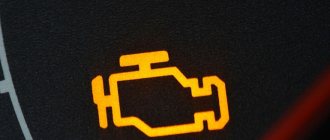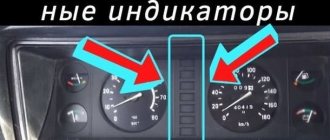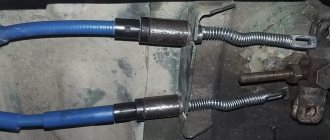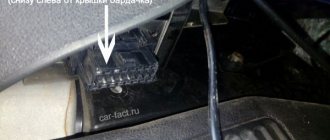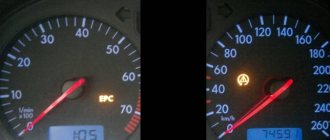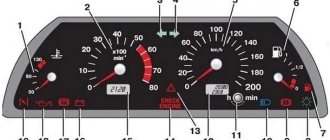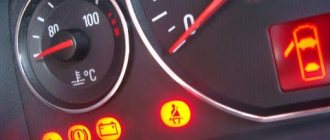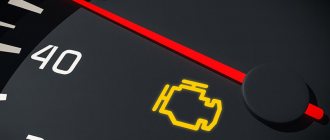Save article:
The article explains:
- What is an ABS light bulb and what is it for?
- Why is the ABS light on?
- Why the ABS light is on and what you should check right away
It happens that a suddenly illuminated ABS light makes some motorists shudder nervously. They believe the entire braking system has failed. The puzzled car owner begins to look on the Internet for a way out of this situation.
However, there is no need to panic. After all, the brakes may be normal, but malfunctions may occur only in the anti-lock braking system, which is not at all critical. The article discusses in detail the question of why the ABS light is on and what should be done to correct the situation.
What is an ABS light bulb and what is it for?
The ABS system controls the braking of the wheels without locking them. Moreover, the car stops quite quickly. If the car owner is forced to brake sharply, thanks to the anti-lock braking system, loss of control of the car will not occur.
Photo: Shutterstock
If the vehicle is not equipped with an anti-lock braking system, or it is inoperative, then when braking sharply, the wheels will block or stop rotating. This can lead to the car skidding, which is especially dangerous when turning. If the ABS light is on on the dashboard, this indicates a problem with the anti-lock system.
It is very easy to check whether the anti-lock braking system is functioning. To do this, the car is accelerated to a speed of 40 km/h and the brakes are sharply pressed to the floor. If the pedal under your foot does not vibrate, it means that the ABS function is faulty - the indicator lights up. Thanks to the anti-lock braking system, you can suddenly “slam on the brakes” and then quickly go around an obstacle.
If there is no ABS function, sharp braking and simultaneous avoidance of obstacles is impossible, since there is a high risk of the vehicle skidding.
The anti-lock braking system consists of the following elements:
- Rotation sensors (all wheels of the car are equipped with them).
- Hydraulic control unit.
- A special mechanism to control the functions of the hydraulic unit.
- ABS lights located on the instrument panel.
Objective reasons why the ABS light may be on are errors on the instrument panel:
- When you start the car engine, all the lights on the dashboard light up, this indicates that the car’s systems are in operating mode. If the automation is fully operational, then within a few minutes all the icons on the display will go out. But when the ABS indicator does not light up when you start the engine, most likely the light bulb is not working.
- A long-burning ABS light indicates a malfunction in the anti-lock braking system. The malfunction is detected by the on-board computer, which recognizes and stores the fault code, and then turns on the signal indicator.
Next, we will talk in more detail about the situation in which the light indicates a malfunction and (or) error in the functioning of the ABS.
Two different aspects of one problem
From a legal point of view, any driving with a faulty brake system is prohibited. This is completely justified, since the driver cannot guarantee a timely stop. If such a violation is detected, the car will be towed to the impound area, and the driver will be punished. In the event of an accident, he will be guilty of driving a defective vehicle. Therefore, according to the law, further movement is impossible.
If we consider the situation purely technically, then the opportunity to slow down will most likely remain. But this cannot be completely guaranteed due to the unpredictability of failure. The danger exists and the cost of that risk is borne by the driver.
Informally, you can take some measures, for example, make sure that the brakes are effective by pressing the pedal sharply at low speed, checking the level of brake fluid in the reservoir, or try to reset the error by removing the terminal from the battery, thereby restarting the ABS computer. It is possible that the light will go out and not come back on. But is it worth the risk? It’s up to the person behind the wheel to decide.
From a safety point of view, everything related to brakes is the most important thing in a car. And this is enshrined in the rules for operating vehicles. No practical advice can be given here; the severity of the possible consequences is too great.
Why the ABS light is on: main reasons
The main reasons why the ABS light on the instrument panel is on:
- There is no contact in the connected connector.
- There is no connection with any sensor, it is likely that the wire has broken.
- The ABS sensor is faulty, so it needs to be checked and, if necessary, replaced with a new one.
- The crown on the hub does not work.
- The anti-lock braking system control unit is faulty.
After a thorough inspection, identification and elimination of the probable source of the breakdown, it is necessary to check the operation of the ABS. To do this, accelerate the car to a speed of 40 km/h. Then you slam on the brakes. If the pedal vibrates and the error light does not light up, then all elements are working.
If, after a visual initial inspection of the sensors, wires, and control unit, no malfunction is identified and the light continues to light, you need to carry out computer diagnostics. Using this procedure, a specific error code issued by the system is detected.
Let's sum it up
Problems with ABS are not very pleasant incidents in any case. It is better to stay away from various problems and try to operate the car according to the requirements and advice of the manufacturer. But sometimes this turns out to be impossible, so it is necessary to have a good service in mind that can help in different situations. By contacting an official service center with this problem, you may become a victim of an overly scrupulous approach to diagnostics and incur huge repair costs.
However, sometimes the problem with the ABS sensor and the light on this system can be solved independently. Use the tips described above in the publication to understand all the features of a particular troubleshooting method. We warn you that it is impossible to completely disable ABS yourself. The on-board computer will either simply not allow the car to start, or will begin to behave inappropriately, producing new diagnostic system error codes each time. Have you encountered incorrect operation of ABS sensors and a constantly burning light?
Why the ABS light is on and what you should check right away
Firstly, in these circumstances, you need to go to a car wash and thoroughly wash the wheel rims. It often happens that after the high-pressure wash is completed, the ABS sensors, which are located near the brake discs, are cleaned. While you're heading to the car wash, test the brake system again. Pick up speed 80 km/h, close the windows in the cabin, turn off the sound of the tape recorder.
If the wheels (front or rear) make a barely audible or annoying hum while driving, then most likely the light indicates a wheel bearing failure.
In addition, additional activities can be carried out:
- Inspect the fuse box, change the module responsible for the functioning of the anti-lock braking system.
- If possible, recognize the error code and ask about it on online forums.
- Contact a specialist who needs to describe the situation in detail, and then try to eliminate the error yourself.
- Raise the car on a jack, unscrew the wheels and see if the ABS sensors are dirty.
- Examine the electronic control unit located under the hood (if there is moisture on it or inside).
- Still, the best way out of this situation is to have the car’s anti-lock braking and electrical systems diagnosed at a service station.
Without a doubt, the last option is the most reasonable, since you can get specific information about the causes of the breakdown (why the ABS light is on), find out whether the problem is serious, and also determine the cost of repairs. Only in this way will you get rid of the problem associated with a burning ABS light and other troubles in the operation of the vehicle.
It will be enough to connect computer diagnostic equipment with the latest program for the most complete and accurate testing of the car and identifying errors. Spend just a few minutes and you will be given the information you need to fix the problem yourself or have it professionally repaired.
How the ABS status indicator should work
Ideally, when the system is working properly and there are no problems, the ABS icon lights up when ignited. The machine simply checks the electronics, reporting this on the display - buttons with indicators begin to blink or light up. Having made sure that the signal is passing normally, the icon begins to go out a couple of seconds after startup. Sometimes the ABS continues to light up, sometimes the icon turns on while driving. This indicates a malfunction of the brake system. It is necessary to carry out an inspection and, if necessary, repairs.
Self-correction of ABS light coming on
Let's consider what measures need to be taken to fix the problem without going to a car repair shop:
- Lift the hood, disconnect the wires leading to the battery.
- The ABS electronic control unit is located directly under the hood. As a rule, it is located together with a hydraulic modulator, which distributes braking forces. This element can be recognized by the large number of brake pipes connected to the block and a bunch of auto wires with a connector.
- Next, you need to disconnect the connector and carefully examine whether there is any damage or liquid on its surface. If necessary, you need to blow out the connector and dry it thoroughly.
- Check the fuses. It's better to do this first, but it's okay if you take such actions at this stage.
Popular articles
The handbrake light is on: how to solve the problem 02.25.2022
15
Gift for a motorist: choosing the best 02/20/2022
96
Grinding noise in the front wheel: causes and methods of “treatment” 02/17/2022
1643
Cylinder failure: causes and diagnostic methods 02/17/2022
67
The car smells like burnt rubber: 3 possible reasons 02/14/2022
1678
The anti-lock braking system is controlled by several fuses. They are most often located in the mounting block located under the hood.
Photo: Shutterstock
Then everything is a little more complicated:
- It's good if you have a car lift to look at. If there is no such installation, you can use a jack. The main thing is to first look at the wires that are connected to the wheel sensors to avoid damage. In most cases, the wiring rubs against the surface of the wheels or flies off the retaining mounts - this leads to the light bulb coming on.
- The design of the sensor on wheels involves connecting it to a wire with a connector attached to the end. The wire can be up to 1 meter long. You need to locate these connectors, check whether they have contact and what quality it is. Inspect the connector surface for moisture or rust.
- If your efforts have led nowhere, and the ABS light is still on, a visit to a car repair shop is necessary. It happens that it is not possible to eliminate the error by “rebooting” (by removing the battery terminals).
You can follow current promotions on the Halva card, which will help you purchase household appliances at a profit, here.
Above we described the steps for independently detecting a malfunction in which the ABS light is on and eliminating it. Car service specialists will connect your car to computer diagnostic equipment, and with its help they will determine the cause of the breakdown. From time to time, quite serious cases arise that require immediate professional help.
Consequences of a faulty ABS
ABS, like any other element of a car, can wear out, losing reliability over time. The essence of the system is to ensure proper braking. Each wheel has a “personal” sensor, which allows you to gradually adjust braking and reduce speed without blocking all wheels at once. A system that is not working correctly will not be able to do this.
You can disable ABS, but you still shouldn’t do it. If the ABS does not perform its functions correctly, damage to the suspension may occur. An ABS lamp that comes on in an unusual situation threatens to cause the driver to simply lose control of the vehicle.
System Features
ABS consists of two parts - electronic and mechanical. The “weak” link in it is the electronics. It is sensitive, so even the slightest negative influences lead to interruptions in operation.
In a car equipped with ABS, there is a warning mechanism that signals the cessation of operation. And he does this by means of a warning light on the dashboard.
When the ignition is turned on, this lamp lights up as self-diagnosis occurs. The system checks its performance, and if no violations are noticed, the lamp goes out, indicating that the ABS is in working condition.
But drivers are faced with the fact that the ABS warning light comes on while driving, and this can only happen under certain conditions. For some, the signal may not go out at all, for others the lamp lights up only when a certain speed is reached. The warning light that comes on confuses the owners, and the reason for this is simple - ABS works with the brakes and they perceive a malfunction of the system as problems with the braking system, which is wrong.
ABS is an addition to a car's braking system that increases its efficiency. Therefore, even if the ABS malfunctions, the car remains able to brake, but you need to get used to the operation of the brakes.
The anti-lock braking system is designed in such a way that if a malfunction is detected, it immediately turns off completely so as not to have any effect on the operation of the brakes.
Car enthusiasts solve an ABS problem by removing the fuse responsible for the operation of the system and postponing troubleshooting until a suitable occasion. But this will not work if the car is equipped with a number of security systems and some of them are based on ABS. In this case, it will not be possible to continue driving, since the electronics will block the operation of a number of components and systems due to a malfunction. It is better not to delay eliminating the cause of the anti-lock braking system malfunction.
